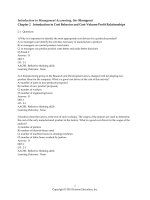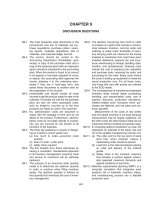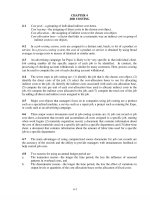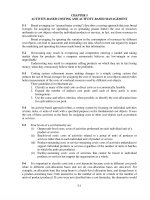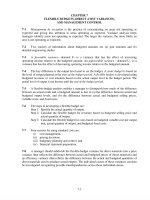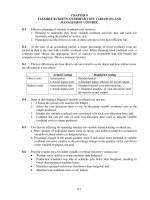Solution manual introduction to management accounting 14e by horngren ch09
Bạn đang xem bản rút gọn của tài liệu. Xem và tải ngay bản đầy đủ của tài liệu tại đây (616.09 KB, 61 trang )
To download more slides, ebook, solutions and test bank, visit
CHAPTER 9
COVERAGE OF LEARNING OBJECTIVES
LEARNING OBJECTIVE
LO1: Describe the relationship of
management control systems to
organizational goals.
LO2: Use responsibility accounting to
define an organizational subunit as a
cost center, a profit center, or an
investment center.
LO3: Develop performance measures
and use them to monitor the
achievements of an organization.
LO4: Explain the importance of
evaluating performance and how it
impacts motivation, goal congruence,
and employee effort.
LO5: Prepare segment income
statements for evaluating profit and
investment centers using the
contribution margin and controllablecost concepts.
LO6: Use a balanced scorecard to
recognize both financial and
nonfinancial measures of
performance.
LO7: Measure performance against
quality, cycle time, and productivity
objectives.
LO8: Describe the difficulties of
management control in service and
nonprofit organizations.
FUNDAMENTAL
ASSIGNMENT
MATERIAL
CRITICAL
THINKING
EXERCISES
AND
EXERCISES
28, 30, 36
A1
28
43
32, 35, 36
42, 44, 45
50
A1, B1
30, 33, 34, 37
42, 43, 48
50, 52, 53, 54
A2, B2
38
43
52, 54
B3
35
45
56
A3, B1
31, 33, 39, 40, 41
46, 47, 48, 49
50, 51
29, 37
495
PROBLEMS
CASES,
EXCEL,
COLLAB., &
INTERNET
EXERCISES
50, 52, 53, 54
50, 53, 55
To download more slides, ebook, solutions and test bank, visit
CHAPTER 9
Management Control Systems and Responsibility Accounting
9-A1 (20 min.)
Excel Electronics Company may have a legitimate claim
against the supplier that would offset the penalty. However, the
disposition of any claim is a separate issue.
The penalty of $30,000 should be charged to the purchasing
department. Jean Schlinger may have done everything in her power
to see that the special part was delivered on time, but she is the one
who is responsible for purchasing necessary material when it is
needed. Schlinger may not have control over her suppliers and
subsequent delivery, but it is her responsibility to have the
purchased parts when they are needed. She is the person in the
organization who has the most influence over delivery. Everybody
makes mistakes. The important point is to minimize the number of
mistakes and also to understand fully that the extensive control
reflected in responsibility accounting is the necessary balance to the
great freedom of action that individual executives are given.
Other questions to discuss are: Did the sales department
behave responsibly in accepting the order with penalty? Is it
conceivable that a careful statistical study of delays by suppliers
would permit the development of an "expected amount" of penalty
to be incurred in a probabilistic sense, which then could be budgeted
as part of the purchasing department's costs?
Discussions of this problem have again and again revealed a
tendency among students (and among accountants and managers) to
"fix the blame" -- as if the variances arising from a responsibility
accounting system should pinpoint misbehavior and provide
answers. The point is that no accounting system or variances can
provide answers ipso facto. However, variances can raise questions.
In this case, in deciding where the penalty should be assigned, the
student might inquire who should be asked in this situation -- not
who should be blamed.
496
To download more slides, ebook, solutions and test bank, visit
9-A2 (30-40 min.) See Exhibit 9-A2 on the following page.
9-A3 (15-20 min.)
1.
Without adjusting for inflation, it appears that both
companies had large increases in productivity in terms of
revenues per employee.
2001
2007
Bohn
$7,658,000 ,000
= $100,896;
75,900
$9,667,000 ,000
=$126,864
76,200
Lewellyn
$5,831,000 ,000
= $103,021;
56,600
6,274,000,000 = $114,489
54,800
However, the 2001 productivity measures should be expressed
in 2007 dollars for comparability:
Bohn
Lewellyn
2001
(1.15 x $7,658,000,000) = $116,030
75,900
(1.15 x $5,831,000,000) = $118,474
56,600
2007
126,864*
114,489*
* Calculation is the same as above for 2007.
2.
Using the productivity measures that are correctly adjusted
for inflation, we see that Lewellyn had a decrease in
productivity between 2001 and 2007. In contrast, Bohn
increased its productivity by $126,864 - $116,030 = $10,834
per employee, an increase of 10,834 ÷ 116,030 = 9.3%.
Although Lewellyn had a decrease in number of employees
and Bohn had an increase, the larger sales increase for Bohn
led to a higher productivity number. While Lewellyn had
slightly higher productivity in 2001, Bohn has the higher
productivity in 2007.
497
To download more slides, ebook, solutions and test bank, visit
EXHIBIT 9-A2 Answers are in thousands of dollars.
Company
as a
Whole
Net Sales
8,000
Variable costs:
Cost of merchandise sold 5,000
Variable operating
expenses
640
Total variable costs
5,640
Contribution margin
2,360
Less: Fixed costs
controllable by
segment managers
960
Contribution controllable
by segment managers 1,400
Less: Fixed costs
controllable by others
490
Contribution by segment 910
Less: Unallocated costs
110
Income before income
taxes
800
Breakdown into
Breakdown of
Breakdown of
Two Divisions
Denver Division
Colorado Springs Division
Colorado
Denver Springs
Not
Not
Division Division AllocatedDowntown Littleton Allocated Downtown PlazaAirport
3,200
4,800
2,400
800
2,400 1,200 1,200
2,000
3,000
1,500
500
1,500
750
750
280
2,280
920
360
3,360
1,440
240
1,740
660
40
540
260
240
1,740
660
60
810
390
60
810
390
305
655
100
125
80
210
125
160
160
615
785
(100)
535
180
(210)
535
230
230
140
475
350
435
35
(135)
70
465
35
145
70
(280)
70
465
105
125
105
125
498
To download more slides, ebook, solutions and test bank, visit
9-B1 (15-20 min.)
1.
It is not possible to determine the validity of Liz Elder’s claim
that the system is disadvantageous to her department. It
would be valid only if, on a proportional basis, the number of
unidentified rejects caused by the other departments were
greater than their proportionate number of identified rejects.
Although the claim cannot be substantiated, a legitimate issue
has been raised. The rejects charged to all the departments
contain amounts not clearly attributable to the respective
departments. This violates the concept that performance
measures should not contain items outside the control of the
manager. Further, a manager's effort to control the variation
will be influenced by the result she can get from her actions.
The fact that some of the rejects are likely caused by other
departments will reduce the amount of the reported rejects
within her control.
2.
There are two solutions to this problem. First, remove the
apportioned rejects from the reports and charge the managers
with only the rejects identified with their department. Second,
if the number of unidentified rejects is large and represents a
large dollar value (which could be reduced if adequate
information as to cause were available), then Kephart
Company should consider inspection at the end of production
in each department.
499
To download more slides, ebook, solutions and test bank, visit
9-B2 (30-35 min.)
1.
See Exhibit 9-B2 on the following page.
2.
The incremental costs of running such sightseeing tours can be
identified with much more confidence than in many other
instances. Net income will be improved by the excess of tour
revenue over such costs; routine allocations of other operating
costs and indirect costs will not be relevant to the decision to
run such tours unless these costs change incrementally with
the tours.
Those railroads that do not run such tours either:
(a) Do not expect incremental revenue to exceed incremental
costs; or
(b) Have other objectives that outweigh the potential
incremental profit from running tours. For example,
some railroads may not want to engage in passenger tours
that would slightly improve short-run profits because
their long-run objective is to reduce passenger business as
much as possible.
3.
If the entire $100,000 of separable discretionary fixed costs can
be avoided by dropping Division No. 2, net income would
decrease by the controllable contribution of $300,000. If only
part of the separable discretionary fixed costs can be avoided,
net income would decrease by between $300,000 and the
contribution margin of $400,000.
In addition, any part of the separable committed costs that
can be saved if Division No. 2 is dropped would reduce the
decrease in income. Of course, if these are truly committed
costs, they cannot be saved (at least in the short run).
500
To download more slides, ebook, solutions and test bank, visit
Exhibit 9-B2
GRAND TRUNK RAILROAD
Income Statement
For the Year Ended December 31, 20X3
(in thousands of dollars)
Revenue..........................
Variable costs ................
Contribution margin ....
Separable discretionary fixed costs ........
Contribution controllable
by segment managers .
Separable committed costs.
Contribution by segments..
Unallocated costs ..........
Income before income
taxes..............................
Breakdown into
Possible Breakdown of
Two Divisions
Passenger Traffic Only
Railroad
PasNot
as a
Freight
senger
AlloDivision
Whole Traffic
Traffic
cable No.1 No.2 No.3
80,000
72,000
8,000
4,000 3,200 800
45,000
36,000
9,000
3,300 2,800 2,900
35,000
36,000
(1,000)
700
400
(2,100)
8,000
7,600
27,000
25,000
2,000
800
28,400
20,000
8,400
1,200
501
400
(1,400)
5,000
(6,400)
80
200
100
20
(80)
500
300
(2,120)
1,000 3,000 700 300
(1,080) (2,500)(400)
(2,420)
To download more slides, ebook, solutions and test bank, visit
9-B3 (25 min)
1. Students will come up with many possible measurements. Among
the possibilities are:
Financial: a. Growth in profitability
Number of new clients
Revenues from new clients
Customer: a. Number of face-to-face meetings with clients
Customer survey – satisfaction scores
b. Number of cases completed on time
Customer survey – how well needs were met
Internal: a. Number of team-based cases handled
Number of staff generated entries to Intranet
b. Internal conflicts and number successfully resolved
Employee survey – ranking in internal communications
c. Number of staff-generated solutions
Ratio of partners to legal staff
Learning: a. Voluntary turnover
Employee survey – satisfaction with environment
b. Percentage of underrepresented minorities
Diversity of undergraduate degrees
Variety of skills and interests represented
502
To download more slides, ebook, solutions and test bank, visit
2. The firm will want to balance the benefits from the balanced
scorecard with the costs of using it. The firm might routinely collect
customer satisfaction scores at the completion of each case. It might
collect employee satisfaction scores once or twice a year. The key
will be to set up a system to 1) carefully define each measure, 2)
collect the needed information, and 3) use the information to provide
feedback on performance. For measures such as number of new
clients or number of face-to-face meetings, collecting the information
will be easy. For more subjective measures, such as customer or
employee satisfaction, the firm must devise detailed measurement
methods. These must be accepted as reasonable bases on which to
assess performance. Finally, the firm must set up a system for
weekly, monthly, quarterly, or annual reporting of the measures and
evaluation of performance based on these reports.
3. The impact of a balanced scorecard will be greater if the firm
bases individual performance evaluations and compensation on the
scorecard results. This can have both benefits and drawbacks.
Among the benefits are 1) aligns staff priorities with firm priorities,
2) focuses staff attention on reaching the firm’s strategic goals, and
3) provides motivation to increase performance in areas that are
important to the firm. Drawbacks include 1) imperfect measures
may lead to dysfunctional behaviors and 2) focus on items measured
in the balanced scorecard may lead to neglect of non-measured
items. Whether to tie compensation to the balanced scorecard
results is a matter of judgment – whether the benefits outweigh the
drawbacks.
9-1 A management control system is a logical integration of
techniques to gather and use information to make planning and
control decisions, to motivate employee behavior, and to evaluate
performance.
503
To download more slides, ebook, solutions and test bank, visit
9-2 A management control system
clearly defines and communicates the organization’s goals
ensures that managers and employees understand the specific
actions required to achieve organizational goals
communicates results and coordinate actions across the
organization, and
motivates managers and employees to achieve the
organization’s goals.
9-3 The major components of a management control system are:
Setting goals and targets
Developing and executing the plan
Measuring, monitoring, and reporting results of actions
Evaluating and rewarding performance
9-4 A key success factor is a characteristic or attribute that must
be achieved in order to drive the organization towards its goals.
Note the difference between a key success factor and an action.
Actions require effort and can be observed on a short-term basis. A
cause-effect statement can be made that relates specific actions (or
activities) to key success factors. “If we ________________ (fill in the
action), then we will __________________ (fill in the key success
factor).” For example, “If we reduce order lead time, then we will be
more responsive to our customers.” Actions are verbs, key success
factors are characteristics or attributes.
9-5 Goals without performance measures may not be completely
useless, but performance measures greatly enhance the achievement
of goals. They provide signals to managers about whether goals are
being achieved.
504
To download more slides, ebook, solutions and test bank, visit
9-6 Some typical corporate goals other than those which
immediately improve profit are (a) growth, (b) high quality
products, (c) market domination, (d) excellent social service, (e) high
prestige, and (f) improved productivity.
9-7 Key success factors are those aspects of performance that are
essential to achieve if the organization is to be successful.
Management examines an organization’s strategic plan and major
goals and decides what factors are most important to achieving its
goals - these are the key success factors.
9-8 Examples of sacrificing long-range goals to short-run
performance gain are:
a. Wasteful disposal of inventory to improve the turnover rate.
b. Maintaining short-run peak personnel efficiency by refusing
to rotate assignments in a way that would improve long-range
flexibility and individual capabilities.
c. Postponing desirable maintenance and repairs.
9-9 Three types of responsibility centers are:
• Cost center - responsibility for control of costs
• Profit center - responsibility for both costs and revenues
• Investment center - responsibility for both profit and
investment.
9-10 Investment centers go a step farther than profit centers. Both
measure profits, but an investment center also compares that profit
to investment using measures such as return on investment, residual
income or EVA (which is discussed in Chapter 10).
505
To download more slides, ebook, solutions and test bank, visit
9-11 Good performance measures will:
• Relate to the organization's goals.
• Balance long-term and short-term considerations.
• Reflect key activities of the organization.
• Be affected by managers' actions.
• Be easily understood by managers and employees.
• Be used in evaluating and rewarding managers and
employees.
• Be reasonably objective and easily measured.
• Be used consistently.
9-12 Examples of nonfinancial measures of performance are
percentage of products delivered on time, proportion of defective
units produced, setup time for a batch of production, average time
from order to delivery, and pounds of output per direct labor hour.
9-13 Goal congruence and motivation are two aspects important to
achieving an organization's goals through managers' actions and
decisions. Goal congruence is achieved if managers seek the goals
sought by top management -- that is, managers aim in the direction
that is best for the organization. Managerial effort is exertion
toward a goal. A good performance evaluation system provides the
managers with appropriate goals and the incentive to achieve the
goals.
9-14 Managers are expected to explain the entire profit of a profit
center, but they are not necessarily evaluated on the entire profit.
Managers have the best information to assess the causes of the
profit. But they should be evaluated on controllable profit. The
objective in evaluation is to measure the effect of the manager's
actions on the profit, and changes in profit due to factors beyond a
manager's control do not indicate anything about the impact of the
manager's actions.
506
To download more slides, ebook, solutions and test bank, visit
9-15 No. Variable costs vary in direct proportion to output, and
fixed costs do not. However, even in the short run a fixed cost may
be controllable by some person or group, and it is almost always
controllable in the long run. Variable costs may be uncontrollable
for very short periods once a decision has been made to perform
some activity.
9-16 No. By deducting separable discretionary costs from the
contribution margin a better measure of short-run performance is
obtained, which might be called the "short-run performance
margin," or contribution controllable by segment managers.
9-17 Examples of segments are divisions, territories, branches,
product lines, and stores.
9-18 Managers should be judged on how well they attain their
currently attainable objectives, focusing on deducting controllable
costs from revenues, whereas the subunit should be judged on its
performance as an economic investment.
9-19 No. The contribution margin format does not ignore items that
are not a part of the contribution margin. Rather, it separates costs
by their behavior (variable and fixed) and by who can control the
cost.
9-20 A balanced scorecard is a performance report that contains
measures of all the key financial and nonfinancial variables that are
important for a company to prosper. Many companies find this a
useful tool to help managers focus on the multidimensional factors
that make an organization successful.
9-21 Key performance indicators are measures that drive the
organization to achieve its goals.
507
To download more slides, ebook, solutions and test bank, visit
9-22 The four categories are:
(a) prevention -- costs incurred to prevent the production of
defective products or services,
(b) appraisal -- costs incurred to identify defective products or
services,
(c) internal failure -- costs of defective products that are scrapped
or reworked, and
(d) external failure -- costs caused by delivery of defective products
or services to customers.
9-23 Many companies are finding that it is less costly to prevent
defects than it is to identify and correct defects.
9-24 Control of nonfinancial performance requires setting
objectives, measuring results, and evaluation of results by
comparing outcomes to expectations (or objectives). This is the
same sequence indicated by control of financial performance.
9-25 Three measures of productivity are:
(a)
Error!
(b)
Error!
(c)
Error!
508
To download more slides, ebook, solutions and test bank, visit
9-26 Comparing productivity measures over time is complicated by
changes in the production process and by inflation. Consider
changes in the production process that substitute one input for
another. Such changes make productivity with respect to the
replaced input increase, while productivity with respect to the input
that is increased will decrease. Further, if either input or output
(but not both) is measured in monetary terms, inflation can distort
productivity measures across time.
9-27 Yes. There are several reasons that developing control
systems in nonprofit organizations is more difficult than in profitseeking organizations, including:
(a) There are often multiple goals, and often the goals are not
explicit.
(b) There is no single, measurable objective such as profit that
determines the trade-off between various goals.
(c) The types of people in nonprofit organizations, frequently
professionals, are often less receptive to the demands imposed
by control systems.
(d) The relationship of inputs to outputs is hard to specify.
(e) A large portion of the costs are discretionary fixed costs, which
are the hardest to manage through a control system.
Nevertheless, control systems can be valuable to nonprofit
organizations.
509
To download more slides, ebook, solutions and test bank, visit
9-28 This question cannot be answered directly from the text. It
requires students to think about an issue closely related to those in
the text.
An article in FE: The Magazine for Financial Executives (Vol.
1, No. 8) addresses these questions. After studying several large
firms that encourage innovation, the author concluded that such
firms had not abandoned sound financial controls or even watered
them down. "The companies surveyed had achieved superior
financial results and had sound financial systems in place ...The
CFO [Chief Financial Officer] in each firm knew the key financial
factors needed for the company's success, and had a financial
control system to carefully track that success" (p.36).
The article made two structure-oriented and five processoriented suggestions to adapt a financial control system to foster
innovation. Regarding structure:
1.
"The primary focus should be on setting up profit centers. A
decentralized organization allows for expanding profit center
accounting. Profit center accountability in turn permits more
discretion and enhances innovation. Our study indicated that
flexibility and entrepreneurial decision-making can be
fostered by a well-structured profit center reporting system."
2.
"A second structural factor in a large, decentralized
organization committed to innovation calls for divisional
financial executives to have a direct, solid-line reporting to the
divisional general manager. However, a solid-line reporting of
divisional financial executives to a corporate senior financial
executive virtually precludes an entrepreneurial spirit at the
division level."
510
To download more slides, ebook, solutions and test bank, visit
The process-related suggestions are these:
a. Planning -- "The successful entrepreneurial firms...have a
well-developed strategy...The strategy is well understood
through all levels of management...Highly structured, precisely
quantified planning is not done...Planning is directed toward
allowing flexibility and changes dictated by the changing
business environment."
b. Budgeting -- "An annual budget, with interim period
breakouts, is well accepted as essential for any successful
business. An entrepreneur is not greatly burdened by and
accepts the need for stating in numbers his or her program for
the coming 12 months."
c. Resource allocation -- "Approval systems for capital
expenditures frequently require extensive reporting to higher
levels of management...The CFO should measure the needs for
capital controls against the driving force of an innovation
entrepreneur. Achieving a fair balance is not easy."
d. Reporting -- "A profit center seeking to be independent and
innovative can lose its thrust if it perceives that every action is
being followed by corporate headquarters through the monthly
financial reporting. The challenge is to provide a system that
maintains financial strength while allowing the flexibility and
independence that produce superior results through innovation
and entrepreneurism."
e. Analyzing operating results -- "One factor in this area
stood out: the frequent reference to comparisons of actual
results to budget, giving full weight to noncontrollable factors
and to changed conditions."
511
To download more slides, ebook, solutions and test bank, visit
9-29 New York City provides a good case study in the consequences
of not identifying and measuring the financial responsibilities of
managers and how adding such measures can lead to organizational
success. A responsibility accounting system keeps top management
informed about activities and decisions made by middle-managers
and can also motivate managers to act in the best interests of the
municipality. Identifying responsibility centers is an important first
step in developing a system. Financial results for each responsibility
center enable top management to know the city's financial situation.
Before developing the IFMS, New York City officials did not know
exactly why the desperate financial situation had developed. IFMS
allows them to anticipate financial demands. It also allows a check
on managers who might tend to be fiscally irresponsible. To
motivate managers, the financial results for a responsibility center
should affect performance evaluation. Of course, non-financial
matters also affect evaluations.
9-30 In an article in the Web magazine Optimize (April 2003) Bruce
Guptill discussed customer-centric metrics. The four most popular
metrics were:
1) customer satisfaction, 2) customer loyalty, 3) decreased
complaints, and 4) increased customer behavior. In addition to
these metrics, Volvo might consider results from research by third
parties such as J. D. Power & Associates, market share data, and
time from order to fulfillment. Students may come up with many
more potential metrics.
9-31 Quality, cycle time, and productivity are related because
improvements in cycle time and productivity are dependent upon
high quality processes and inputs. High quality depends on good
product (or service) and process designs, highly trained employees,
and commitment to continuous improvement. These factors also
lead to improvements in cycle time and productivity.
512
To download more slides, ebook, solutions and test bank, visit
9-32 (5 min.)
There are many possible answers for each company or organization.
Examples are:
Northwest Airlines: Percent on-time arrivals, capacity utilization
Wal Mart: Number of standard stocking units (sku’s); sales per
square foot of space
Hewlett-Packard: Number of new products, product development
time
New York Department of Motor Vehicles: cost of services,
number of licenses issued per employee
9-33 (20 min.)
Plant maintenance should be charged the standard
maintenance labor rate of $14.00. The $6.00 hourly rate difference
($20.00 - $14.00) could be charged to Loss from Idle Capacity or
some similar account. From a control viewpoint, the loss should be
the responsibility of the individual who decides to retain the welders
rather than to lay them off.
Charging plant maintenance the standard rate of $14.00
assumes that the welders are qualified to do the normal plant
maintenance work. It is up to the plant maintenance supervisor to
get $14.00 worth of work from the welders. The $6.00 hourly rate
difference should certainly not be charged to plant maintenance
since the regular help need be paid only $14.00.
Because the welders must be retained in order to maintain
high quality workmanship, and perhaps the reputation and sales
position of the company, a conceptual case could even be made for
treating the $6.00 as an asset because the decision to keep highpriced personnel implies a future cost saving, possibly in hiring and
training new employees, or a future revenue enhancement. Because
the value of this “asset” is highly contingent on future events, this is
rarely done in practice.
513
To download more slides, ebook, solutions and test bank, visit
9-34 (35 min.)
1.
Compensation:
If quota is met: ¥50,000 + ¥68,000+.05 x (actual - quota)
If quota is not met:
¥50,000
January
February
March
April
2.
A
¥ 50,000
190,750
226,000
50,000
Clerk
B
¥118,000
118,000
50,000
118,250
C
¥193,000
50,000
413,500
50,000
Notice the wide variation in month-to-month sales and the
even wider variation in compensation. The variation suggests
that sales are only partially under the control of the
salesclerks. Therefore, it is likely to be almost impossible for
the salesclerks to continually increase sales by 3% per month.
Given sales quotas of 103% of the previous month's actual
sales, the bonus of ¥68,000 plus 5% commission on sales over
quota is extremely high and provides incentive for
manipulation rather than overall sales effort. In any given
month, the salesclerks have incentives to either a)meet or
surpass their quota (to earn the substantial bonus), or b)miss
the quota by a substantial amount (to lower the quota as much
as possible for the subsequent month). The incentives are also
affected by the salesclerk’s sales volume.
With the relatively small sales volume, salesclerk B has an
incentive to just meet his or her quota several months running
and then have a low volume month to bring the quota down in
preparation for another run of months of just meeting the
quota.
514
To download more slides, ebook, solutions and test bank, visit
Salesclerks A and C, with larger sales volumes, are better off
financially to surpass their sales quotas by substantial
amounts and then have a low volume month to bring down
their quotas in preparation for a large bonus the following
month.
The bonus system should be modified. If an incentive is to be
provided, the quotas should be tied to a more reasonable
standard of what constitutes a normal month's sales (and
should specifically not be tied directly to the previous month's
sales). Most companies believe a bonus payment should be
small in relation to basic compensation and should be related
to actual sales effort rather than to clever manipulation.
Moreover, most companies believe that most compensation
should be tied to performance over a longer time span than
one month. A yearly span would not tempt nearly as much
manipulation.
515
To download more slides, ebook, solutions and test bank, visit
9-35 (10 min.)
Students may classify some of these measures differently than shown
here. The point should be made that the important feature in a
balance scorecard is to have all perspectives represented.
PERFORMANCE MEASURE
Return on sales
Retention of target customers
Net cash flow
Training hours
Employee turnover rate
Material handling cost per unit
Market share
Product development cycle time
Revenue growth in segments
Occupational injuries and illness
Days sales in inventory
Average cost per invoice
PERSPECTIVE
Financial
Customer
Financial
Learning and growth
Learning and growth
Internal process, financial
Customer
Internal process
Financial
Learning and growth
Internal process, financial
Internal process, financial
516
To download more slides, ebook, solutions and test bank, visit
9-36 (10-15 min.) Students will suggest many different goals and
measures in each area. This solution lists one possibility for each of
the five areas.
Customer Satisfaction Goal: Reduce customer waiting time
Measure: Average time from check-in until seeing a physician
Efficient use of lab tests Goal: Reduce unnecessary lab tests
Measure: Lab tests per patient (categorized by diagnosis)
Usage of physician time Goal: Decrease time physicians spend on administrative and
clerical tasks
Measure: Patients seen per hour of physician time or, better,
percentage of physician time spent with patients
Maintain state-of-the-art facilities Goal: Provide patients with access to latest technology
Measure: Amount of capital expenditures or, better, percent
of equipment below standard
Overall financial performance Goal: ROI exceeding the 75th percentile in the industry
Measure: Return on investment
This is a good time to discuss the cost/benefit tradeoff with
possible performance measures. Sometimes the best performance
metric is just too costly to measure. For example, use of physician
time is better measured by the percentage of their working time that
is spent seeing patients than by number of patients per hour of
physician time. But the better measure requires physicians to log
the time they spend on various activities. This may be too costly,
both in terms of the time it takes and the resistance from physicians,
so the less desirable metric, patients per hour, might be used.
517
To download more slides, ebook, solutions and test bank, visit
9-37 (15-20 min.)
Increasing sales activity can be related to increased number of
new accounts; thus many stock brokerages set objectives for its
brokers to make a set number of "cold calls" to solicit investments
from potential clients. However, a large number of small accounts
probably do not have the same impact on sales as a few large
accounts.
The brokerage firm must be careful not to divert its
employees' energies so much to finding new accounts that research,
analysis, and existing accounts are neglected. Service firms have
found that it is much more profitable to retain existing customers
than to find new customers. Therefore, customer retention has
become a major objective, and performance is measured on
activities that are believed to aid in retaining profitable customers.
These measures include how quickly phones are picked up, how
quickly inquiries are answered, accessibility of data bases, and so
on.
518
To download more slides, ebook, solutions and test bank, visit
9-38 (15 - 20 min.)
1.
Revenues
Variable costs
Contribution margin
Fixed costs controllable
by restaurant managers
Contribution controllable
by restaurant managers
Fixed costs controllable
by others
Contribution by restaurant
Unallocated costs
Operating income
Company
Duluth
Superior
$1,700,000 $850,000
$850,000
1,105,000 510,000
595,000
595,000
340,000
255,000
175,000
125,000
50,000
420,000
215,000
205,000
290,000
130,000
70,000
$ 60,000
110,000
$105,000
180,000
$25,000
2. a. The new restaurant in Superior is not yet as profitable as the
Duluth restaurant. The advertising campaign to build up the
customer base in Superior weighs heavily on the profits of the
Superior restaurant. However, both restaurants have a positive
contribution after subtracting all costs that the company can
specifically identify with individual restaurants.
b. The two managers have almost equal levels of performance, with
the Duluth manager having $10,000 more controllable contribution.
The lower contribution margin in Superior is offset by its lower rent
and other fixed costs that the manager controls. Although the two
managers reach their level of profitability by different means (that
is, by a different mix of costs), they seem to both be performing well.
519
